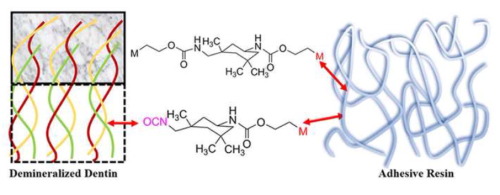当前位置:
X-MOL 学术
›
Acta Biomater.
›
论文详情
Our official English website, www.x-mol.net, welcomes your
feedback! (Note: you will need to create a separate account there.)
Isocyanate-terminated urethane-based dental adhesive bridges dentinal matrix collagen with adhesive resin.
Acta Biomaterialia ( IF 9.4 ) Pub Date : 2018-11-07 , DOI: 10.1016/j.actbio.2018.11.007 Rongchen Xu 1 , Fan Yu 1 , Li Huang 2 , Wei Zhou 1 , Yan Wang 1 , Fu Wang 1 , Xiang Sun 1 , Gang Chang 1 , Ming Fang 1 , Ling Zhang 1 , Fang Li 1 , Franklin Tay 3 , Lina Niu 3 , Jihua Chen 3
Acta Biomaterialia ( IF 9.4 ) Pub Date : 2018-11-07 , DOI: 10.1016/j.actbio.2018.11.007 Rongchen Xu 1 , Fan Yu 1 , Li Huang 2 , Wei Zhou 1 , Yan Wang 1 , Fu Wang 1 , Xiang Sun 1 , Gang Chang 1 , Ming Fang 1 , Ling Zhang 1 , Fang Li 1 , Franklin Tay 3 , Lina Niu 3 , Jihua Chen 3
Affiliation

|
Commercially available dental adhesives fail to chemically unite the demineralized collagen matrix with resinous materials within the resin-dentin interface. Sub-micron separations between the collagen fibrils and polymerized resin provide the backdrop for bond deterioration. Here, novel isocyanate-terminated urethane methacrylate precursors (UMP) were synthesized with the capacity to bond chemically to dentin collagen via covalent and hydrogen bonds. Collagen grafted with UMP also copolymerized with other methacrylate resin monomers, thereby producing a monoblock of chemically-linked biocomposite. The viscosity, degree of conversion and biocompatibility of UMP are comparable with commercially available resin monomers. An experimental adhesive containing 40% UMP demonstrated co-polymerization capability, good infiltration capacity and achieved higher immediate bond strength to dentin than the control commercially available adhesive. Improvement of dentin bonding by incorporation of UMP into dentin adhesives justifies future evaluation of the potential of these UMP-based adhesives in extending the longevity of resin-dentin bonds. STATEMENT OF SIGNIFICANCE: Composite-adhesive restorations have become an indispensable treatment modality in contemporary restorative dentistry. While the inability of these adhesives to bond chemically with collagen undermines the bond quality. This study describes a novel isocyanate-terminated urethane multi methacrylate precursors (UMP) which can bridge dentinal matrix collagen with adhesive resin by covalent and hydrogen bonds. Furthermore, an experimental UMP-based adhesive shows better co-polymerization capability, good infiltration capacity and higher immediate bond strength than the putatively effective adhesive Single Bond 2. The new chemical bonding mechanism based on UMP would theoretically produce more stable bonding interface that are more resistant to degradation.
中文翻译:

异氰酸酯封端的氨基甲酸酯基牙科胶粘剂将牙本质基质胶原蛋白与胶粘剂树脂桥接在一起。
可商购的牙科用粘合剂不能将脱矿的胶原蛋白基质与树脂-牙本质界面内的树脂材料化学结合。胶原原纤维和聚合树脂之间的亚微米分离为键变差提供了背景。在这里,合成了新型异氰酸酯封端的氨基甲酸酯甲基丙烯酸酯前体(UMP),其具有通过共价键和氢键化学键合到牙本质胶原的能力。用UMP接枝的胶原蛋白还与其他甲基丙烯酸酯树脂单体共聚,从而产生化学连接的生物复合材料的单嵌段。UMP的粘度,转化度和生物相容性可与市售树脂单体媲美。含有40%UMP的实验胶粘剂具有共聚能力,与对照市售粘合剂相比,它具有良好的渗透能力,并获得了更高的牙本质即时粘合强度。通过将UMP掺入牙本质粘合剂中来改善牙本质粘合,证明了对这些基于UMP的粘合剂在延长树脂-牙本质键的寿命方面的潜力的未来评估是有道理的。意义声明:复合胶粘剂修复已成为当代修复牙科中必不可少的治疗方式。这些胶粘剂无法与胶原化学键合会破坏键合质量。这项研究描述了一种新型的异氰酸酯封端的氨基甲酸酯多甲基丙烯酸酯前体(UMP),它可以通过共价键和氢键将牙本质基质胶原蛋白与粘性树脂桥接。此外,实验性的基于UMP的胶粘剂显示出更好的共聚能力,
更新日期:2018-11-08
中文翻译:

异氰酸酯封端的氨基甲酸酯基牙科胶粘剂将牙本质基质胶原蛋白与胶粘剂树脂桥接在一起。
可商购的牙科用粘合剂不能将脱矿的胶原蛋白基质与树脂-牙本质界面内的树脂材料化学结合。胶原原纤维和聚合树脂之间的亚微米分离为键变差提供了背景。在这里,合成了新型异氰酸酯封端的氨基甲酸酯甲基丙烯酸酯前体(UMP),其具有通过共价键和氢键化学键合到牙本质胶原的能力。用UMP接枝的胶原蛋白还与其他甲基丙烯酸酯树脂单体共聚,从而产生化学连接的生物复合材料的单嵌段。UMP的粘度,转化度和生物相容性可与市售树脂单体媲美。含有40%UMP的实验胶粘剂具有共聚能力,与对照市售粘合剂相比,它具有良好的渗透能力,并获得了更高的牙本质即时粘合强度。通过将UMP掺入牙本质粘合剂中来改善牙本质粘合,证明了对这些基于UMP的粘合剂在延长树脂-牙本质键的寿命方面的潜力的未来评估是有道理的。意义声明:复合胶粘剂修复已成为当代修复牙科中必不可少的治疗方式。这些胶粘剂无法与胶原化学键合会破坏键合质量。这项研究描述了一种新型的异氰酸酯封端的氨基甲酸酯多甲基丙烯酸酯前体(UMP),它可以通过共价键和氢键将牙本质基质胶原蛋白与粘性树脂桥接。此外,实验性的基于UMP的胶粘剂显示出更好的共聚能力,











































 京公网安备 11010802027423号
京公网安备 11010802027423号